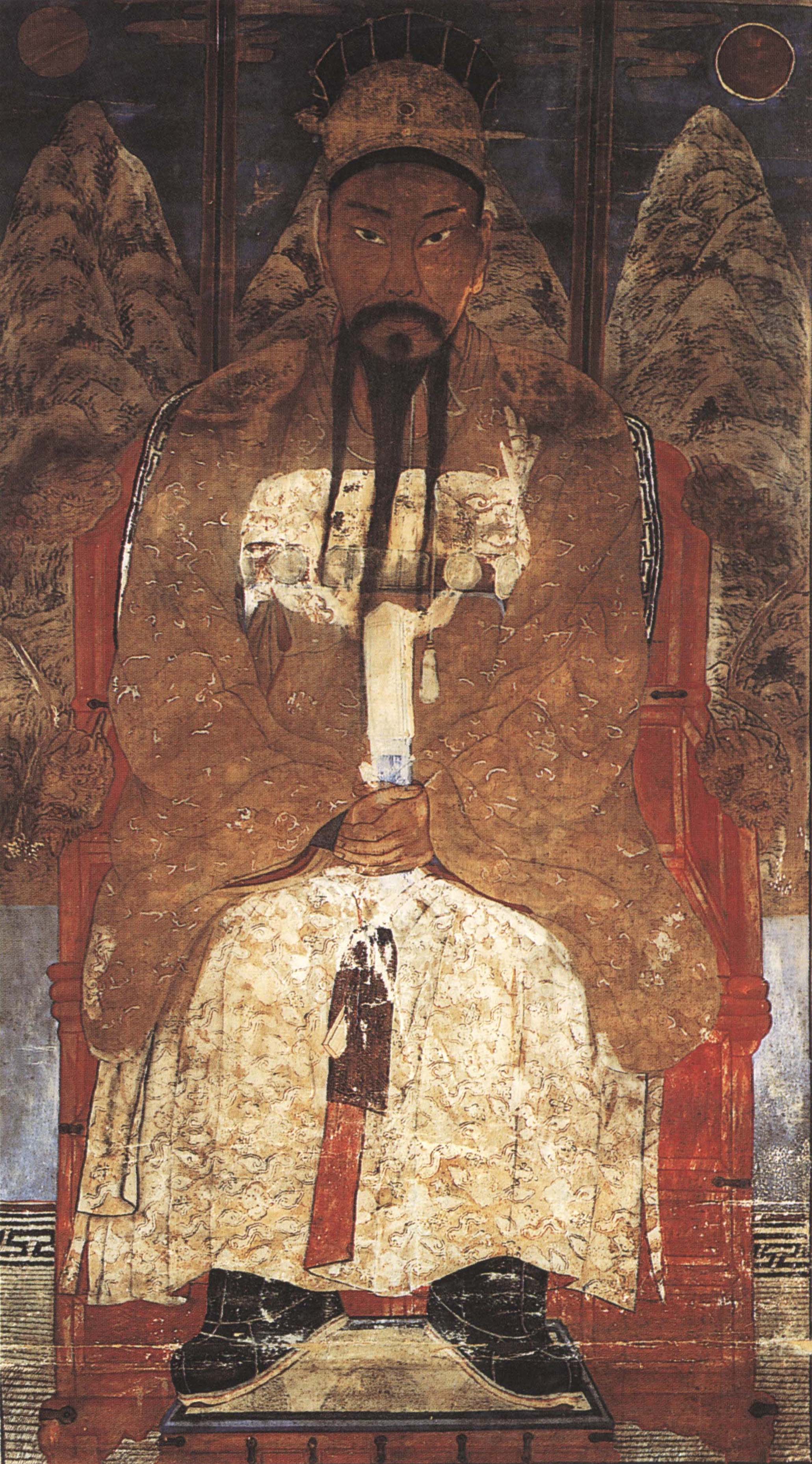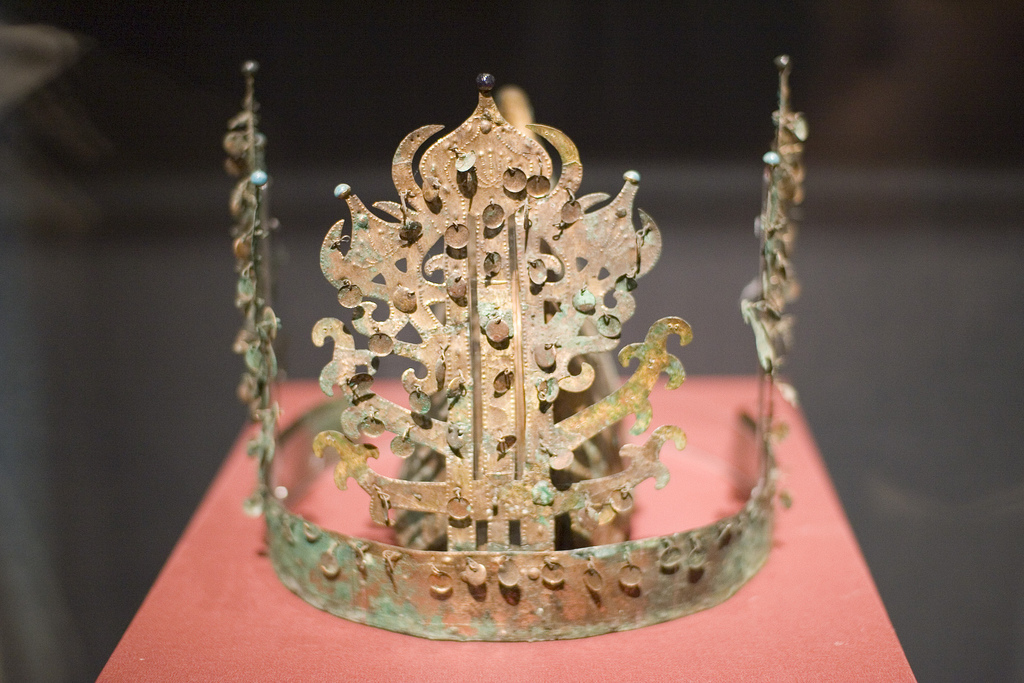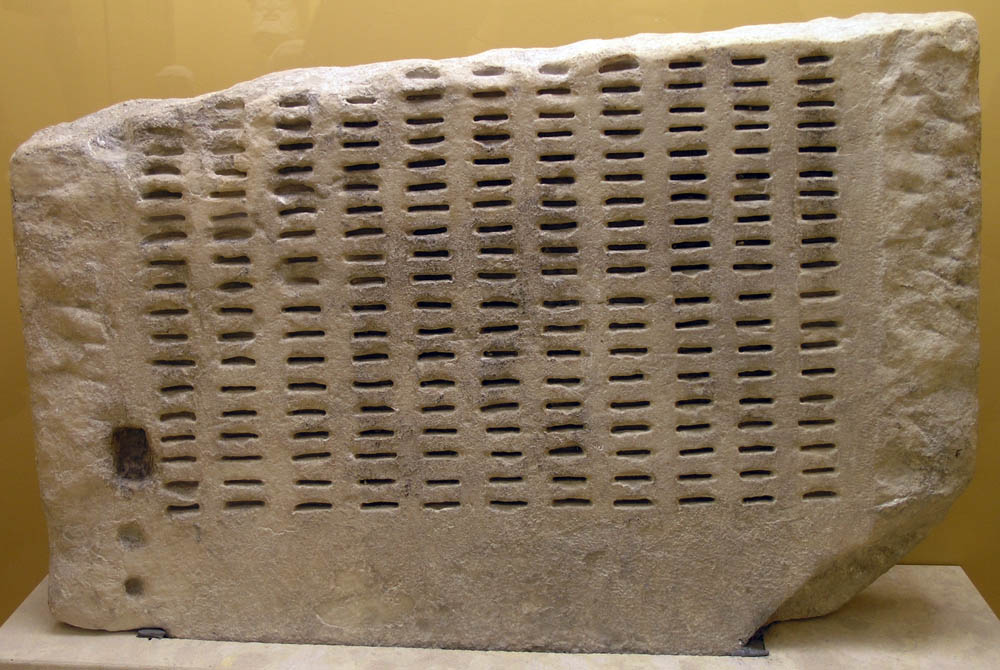|
Baekje Government
The Government of Baekje, was the court system of Baekje (百濟), one of the Three Kingdoms of Korea which lasted from 18 BCE–660 CE. The establishment of a centralized state in Baekje is usually traced to the reign of King Goi, who may have first established patrilineal succession. Like most monarchies, a great deal of power was held by the aristocracy. King Seong, for example, strengthened royal power, but after he was slain in a disastrous campaign against Silla, the nobles took much of that power away from his son. The Hae clan and the Jin clan were the representative royal houses who had considerable power from the early period of Baekje, and they produced many queens over several generations. The Hae clan was probably the royal house before the Buyeo clan (扶餘氏) replaced them, and both clans appear descended from the lineage of Buyeo and Goguryeo. The " Great Eight Families" (Sa, Yeon, Hyeop, Hae, Jin, Guk, Mok, and Baek) were powerful nobles in the Sabi era ... [...More Info...] [...Related Items...] OR: [Wikipedia] [Google] [Baidu] |
Baekje
Baekje or Paekche (; ) was a Korean kingdom located in southwestern Korea from 18 BCE to 660 CE. It was one of the Three Kingdoms of Korea, together with Goguryeo and Silla. While the three kingdoms were in separate existence, Baekje had the highest population of approximately 3,800,000 people (760,000 households), which was much larger than that of Silla (850,000 people) and similar to that of Goguryeo (3,500,000 people). Baekje was founded by Onjo of Baekje, Onjo, the third son of Goguryeo's founder King Dongmyeong of Goguryeo, Jumong and Soseono, at Wiryeseong (present-day southern Seoul). Baekje, like Goguryeo, claimed to succeed Buyeo kingdom, Buyeo, a state established in present-day Manchuria around the time of Gojoseon's fall. Baekje alternately battled and allied with Goguryeo and Silla as the three kingdoms expanded control over the peninsula. At its peak in the 4th century, Baekje controlled most of the western Korean peninsula, as far north as Pyongyang, and may ha ... [...More Info...] [...Related Items...] OR: [Wikipedia] [Google] [Baidu] |
Balhae
Balhae,, , ) also rendered as Bohai or Bohea, and called Jin (; ) early on, was a multiethnic kingdom established in 698 by Dae Joyeong (Da Zuorong). It was originally known as the Kingdom of Jin (震, Zhen) until 713 when its name was changed to Balhae. At its greatest extent it corresponded to what is today Northeast China, the northern half of the Korean Peninsula and the southeastern Russian Far East. Balhae's early history involved a rocky relationship with the Tang dynasty that saw military and political conflict, but by the end of the 8th century the relationship had become cordial and friendly. The Tang dynasty would eventually recognize Balhae as the "Prosperous Country of the East". Numerous cultural and political exchanges were made. Balhae was conquered by the Khitan people, Khitan-led Liao dynasty in 926. Balhae survived as a distinct population group for another three centuries in the Liao and Jin dynasty (1115–1234), Jin dynasties before disappearing under Mong ... [...More Info...] [...Related Items...] OR: [Wikipedia] [Google] [Baidu] |
List Of Korean Monarchs
This is a list of monarchs of Korea, arranged by dynasty. Names are romanized according to the South Korean Revised Romanization of Korean. McCune–Reischauer romanizations may be found at the articles about the individual monarchs. Gojoseon Gojoseon (2333 BC – 108 BC) was the first Korean kingdom. According to legend, it was founded by Dangun in 2333 BC. Bronze Age archaeological evidence of Gojoseon culture is found in northern Korea and Liaoning. By the 9th to 4th century BC, various historical and archaeological evidence shows Gojoseon was a flourishing state and a self-declared kingdom. Both Dangun and Gija are believed to be mythological figures, but recent findings suggest and theorize that since Gojoseon was a kingdom with artifacts dating back to the 4th millennium BC, Dangun and Gija may have been royal or imperial titles used for the monarchs of Gojoseon, hence the use of Dangun for 1900 years. * : "An extreme manifestation of nationalism and the family cult was ... [...More Info...] [...Related Items...] OR: [Wikipedia] [Google] [Baidu] |
List Of Baekje Researchers
Baekje or Paekche (; ) was a Korean kingdom located in southwestern Korea from 18 BCE to 660 CE. It was one of the Three Kingdoms of Korea, together with Goguryeo and Silla. While the three kingdoms were in separate existence, Baekje had the highest population of approximately 3,800,000 people (760,000 households), which was much larger than that of Silla (850,000 people) and similar to that of Goguryeo (3,500,000 people). Baekje was founded by Onjo, the third son of Goguryeo's founder Jumong and Soseono, at Wiryeseong (present-day southern Seoul). Baekje, like Goguryeo, claimed to succeed Buyeo, a state established in present-day Manchuria around the time of Gojoseon's fall. Baekje alternately battled and allied with Goguryeo and Silla as the three kingdoms expanded control over the peninsula. At its peak in the 4th century, Baekje controlled most of the western Korean peninsula, as far north as Pyongyang, and may have even held territories in China, such as in Liaoxi, t ... [...More Info...] [...Related Items...] OR: [Wikipedia] [Google] [Baidu] |
List Of Baekje People
This is a list of known people who lived in Baekje 18 BCE – 660 CE. Rulers ''For a chronological list of rulers, see List of Korean monarchs''. Military leaders/Political leaders * Wutae (우태, 優台, ?–?), father of the founders of Baekje, Onjo and Biryu. *Dongmyeong of Goguryeo (동명성왕, 東明聖王, 58–19BCE), step-father of the founders of Baekje, Onjo and Biryu. In separate legends he is their father or at least the father of Onjo. *So Seo-no (소서노, 召西奴, 77–6 BCE), mother of the founders of Baekje, Onjo and Biryu. *Buyeo clan (扶餘氏) – royal family of Baekje. ** Biryu (비류, 沸流, ?–?), older brother of the first king, Onjo. ** Tokusa-Ō (덕좌왕, 德佐王, ?–?), son of King Onjo of Baekje who settled in Japan. ** Buyeo Usu (부여우수, 扶餘優壽, ?–?) – son of the 3rd king, Gaeru of Baekje. The only record of him is in the Samguk Sagi in 260 when he was appointed Minister of the Interior (內臣佐平, Naesin-jwa'pyeong ... [...More Info...] [...Related Items...] OR: [Wikipedia] [Google] [Baidu] |
Ungjin Commandery
The Ungjin Commandery was an administrative division of the Chinese Tang dynasty that existed between 660 and 671 on the Korean Peninsula. It was created in place of Baekje in present-day Chungcheong Province after its defeat by a joint Silla-Tang alliance, but was destroyed only a few years after due to a counterattack by Silla and remnant Baekje forces. The Tang dynasty moved the now nonexistent Ungjin Commandery into the Protectorate General to Pacify the East. Those political organizations renamed the newly conquered areas under the Jimi system. History In the year of 660, Ungjin Commandery is a administrative subdivision set up for the purpose of governing the old Baekje area which is current Chungcheong Province. At that time, Ungjin (Administrative center・Sabi castle also known as Goma castle, which is currently called Chungcheong Province, Buyeo County), Mahan confederacy (Gosaburi castle, North Jeolla Province, Jeongeup), Dongmyeong Province, Ungjin castle, Chungcheong ... [...More Info...] [...Related Items...] OR: [Wikipedia] [Google] [Baidu] |
Wiryeseong
Wiryeseong () was the name of two early capitals of Baekje, one of the Three Kingdoms of Korea. Both are believed to have been in the modern-day Seoul area. According to ''Samguk Sagi'' (the oldest surviving Korean history book, written in the 12th century), Onjo, the son of Goguryeo's founder Jumong, founded the nation of ''Sipje'' (십제, 十濟; later became ''Baekje'') on Wiryeseong in 18 BC, while his elder brother Biryu established himself in Michuhol (미추홀, 彌鄒忽) further to the west. The location of Michuhol is usually believed to be present-day Incheon. After some time, Biryu recognized that Michuhol's land was too barren and saline to sustain his people, so he moved to Wiryeseong with his people (Shortly after, the name of the state is changed from ''Sipje'' to ''Baekje''). Later, Onjo moved further south because of Malgal to the north and Lelang to the east. The former Wiryeseong is called Habuk (north of the river) Wiryeseong and the latter is called H ... [...More Info...] [...Related Items...] OR: [Wikipedia] [Google] [Baidu] |
Crown Of Baekje
The Crown of Baekje refers to several artifacts excavated that are believed to be the royal headgear of the kings, queens, and nobility of the Baekje Kingdom. Some of the crowns follow the same tradition as Silla crowns in that they share the tree-motif and the hints of shamanistic traditions. However, the diadems of the kings and queens suggest that Baekje people had a distinct tradition for their royal headgear. National Treasure of Korea No.154 The Geumjegwansik are a pair of two gold diadems that were worn by the king of Baekje. Designated on July 9, 1974, they are the 154th national treasure of Korea. The Gongju National Museum currently holds these diadems in their collection. They were excavated from the King Muryeong's tomb in Gongju, South Korea in 1971. The diadems were neatly stacked on top of each other and were found placed near the head of the king in the coffin. The first of the pair of diadems is 30.7 centimeters tall and 14 centimeters in width, while the sec ... [...More Info...] [...Related Items...] OR: [Wikipedia] [Google] [Baidu] |
Selection By Lot
In governance, sortition is the selection of public officials or jurors at random, i.e. by lottery, in order to obtain a representative sample. In ancient Athenian democracy, sortition was the traditional and primary method for appointing political officials, and its use was regarded as a principal characteristic of democracy. Sortition is often classified as a method for both direct democracy and deliberative democracy. Today sortition is commonly used to select prospective jurors in common-law systems. What has changed in recent years is the increased number of citizen groups with political advisory power, along with calls for making sortition more consequential than elections, as it was in Athens, Venice, and Florence. History Ancient Athens Athenian democracy developed in the 6th century BC out of what was then called isonomia (equality of law and political rights). Sortition was then the principal way of achieving this fairness. It was utilized to pick most of the magis ... [...More Info...] [...Related Items...] OR: [Wikipedia] [Google] [Baidu] |
Il-yeon
Il-yeon (; 1206–1289), also spelled Iryeon, was a Korean Buddhist monk and All-Enlightened National Preceptor () during the Goryeo Dynasty of Korea. His birth name was either Kim Gyeong-myeong () or Jeon Gyeon-myeong (), and his courtesy name was Hoe-yeon (). He became a monk at the temple Muryangsa at the age of nine and passed the Seon national examination at 22. At 54, he was given the rank of Great Teacher. When he was 78, King Chungnyeol offered him a position of rank and tried to make him National Preceptor, but Il-yeon declined. The king again appointed him National Preceptor, and Il-yeon came down to the capital Kaesong (then Gaegyeong) but soon returned to the mountains on the pretext that his aged mother was sick. On the eighth day of the seventh month in 1289, he held a conference with various monks and then died. Il-yeon is known as a prolific writer, and according to the inscription on his tombstone, he wrote around 80 volumes on Buddhist topics. Today only one ... [...More Info...] [...Related Items...] OR: [Wikipedia] [Google] [Baidu] |
Samguk Yusa
''Samguk yusa'' (; ) or ''Memorabilia of the Three Kingdoms'' is a collection of legends, folktales, and historical accounts relating to the Three Kingdoms of Korea (Goguryeo, Baekje, and Silla), as well as to other periods and states before, during, and after the Three Kingdoms period. It was compiled by the Buddhism, Buddhist monk Il-yeon in the late Goryeo dynasty, around 1280. It is the earliest extant record of the Dangun legend, which records the founding of Gojoseon as the first Korean nation. ''Samguk yusa'' is National Treasure No. 306. ''Samguk yusa'' is a history record composed of five volumes divided into nine parts. It documents various tales and legends which are categorized into two parts: historical events and Buddhist narratives. The text contains various historical narratives such as tales of the Three Kingdoms period, myths, legends, genealogies, histories, and Buddhist tales, which have helped maintain folklore from medieval Korea. "Yusa" is a term used to d ... [...More Info...] [...Related Items...] OR: [Wikipedia] [Google] [Baidu] |
Daru Of Baekje
Daru (?–77, r. 28–77) was the second king of Baekje, one of the Three Kingdoms of Korea. Background He was the eldest son of the founding monarch Onjo and became the heir of throne in the year 10. He became king upon Onjo's death in 28 which was the 46th year of his reign. The ''Samguk sagi'' records that "''he was a generous man and had presence and esteem''".Samguk sagi, Scroll 23 Reign The ''Samguk sagi'' records many battles against the "Malgal" during Daru's reign. It is unclear who this refers to, as the Mohe tribes are thought to have occupied Manchuria northwest of the northern Korean kingdom Goguryeo, far from Baekje's capital (generally presumed to have been in the present-day Seoul region). The "Malgal" do not appear to refer to the Buyeo people that founded Baekje, nor to the Mahan confederacy tribes subjugated by Baekje. They appear to have remained from the earlier period, incited by Chinese commanderies to attack Baekje. The battles indicate that Baekje as ... [...More Info...] [...Related Items...] OR: [Wikipedia] [Google] [Baidu] |





